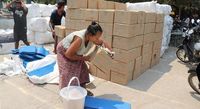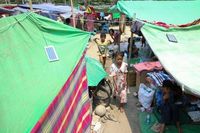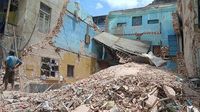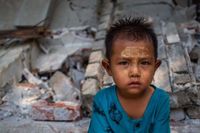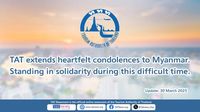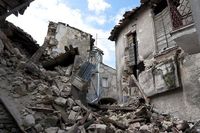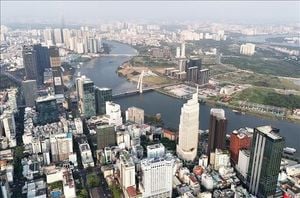On March 28, 2025, Myanmar was struck by a devastating magnitude 7.9 earthquake that has since led to significant loss of life and widespread destruction. As the nation grapples with the aftermath, international responses have varied dramatically, highlighting stark contrasts in humanitarian aid efforts.
The earthquake, which caused catastrophic damage, has resulted in over 3,600 confirmed deaths, with more than 5,000 injured and hundreds still reported missing. The disaster has affected more than nine million people across Myanmar, including 2.7 million children, with critical infrastructure suffering extensive damage. Reports indicate that over 190 healthcare facilities and more than 2,300 schools have been severely impacted, complicating the relief efforts.
In the wake of the disaster, countries and organizations rushed to provide assistance. Among them, China emerged as a leading supporter, demonstrating swift action by allocating 100 million yuan in emergency humanitarian aid. U Tin Maung Swe, Myanmar's ambassador to China, expressed gratitude for this rapid response, stating, "Benevolence and good neighborliness are the treasures of a nation." He emphasized that the aid fostered a sense of profound 'Paukphaw' (fraternal) friendship between the two nations.
Just 18 hours after the earthquake struck, a 37-member rescue team from Yunnan province arrived in Myanmar, marking the first international team to reach the disaster zone. Equipped with advanced life-detection equipment, they successfully rescued the first survivor in the early hours of March 30. By the evening of the same day, China had deployed four official rescue teams comprising 288 personnel, including teams from the Hong Kong Special Administrative Region. Over the following days, these teams managed to save nine survivors and delivered essential relief supplies, including tents, blankets, water, and food, in multiple batches by April 11.
In contrast, the response from the United States has been criticized for its sluggishness. Prior to the earthquake, the U.S. Agency for International Development (USAID) had downsized its operations, leaving only 78 staff members available for disaster relief. Reports revealed that 14 of the 15 USAID officials in Myanmar responsible for overseeing relief funds had been placed on indefinite leave just before the earthquake. As a result, the U.S. response was delayed, with the US Embassy announcing a mere $2 million in aid two days after the quake.
On April 3, the U.S., together with Japan, India, and Australia, issued a joint statement through the Quadrilateral Security Dialogue (Quad), pledging over $20 million in supplies. However, observers noted that this initiative, initially established to address the Indian Ocean tsunami, has since been perceived as a U.S.-led bloc aimed at countering China rather than focusing on disaster relief.
U.S. Secretary of State Marco Rubio defended the slow response, stating, "Our resources are not unlimited," while urging China to take the lead in humanitarian efforts. Critics have labeled the U.S. absence in Myanmar's early response a "moral and strategic failure," with The New York Times attributing the delay to Washington's dysfunction and diminished capacity for foreign aid.
The earthquake's impact has been profound, with the UN appealing for $275 million to assist affected communities, and the UN High Commissioner for Refugees (UNHCR) requesting $16 million to help 1.2 million people. As the situation continues to evolve, the scale of the disaster underscores the fragility of human life in the face of natural calamities.
Seismologists have also provided insights into the earthquake's geological implications. The quake ruptured more than 400 kilometers of the Sagaing fault, a major lateral plate boundary in Myanmar. This rupture is notable for being one of the largest observed globally, and it has prompted an increase in seismic activity in neighboring regions such as Thailand and parts of China.
Research indicates that the earthquake produced damaging shaking that extended over 100 kilometers from the fault line, affecting cities such as Mandalay, Nay Pyi Taw, and Bago. The shaking was so severe that it likely reached Modified Mercalli Intensity values exceeding VIII, indicating significant structural damage and challenges for those attempting to provide aid.
In a further testament to the evolving nature of disaster response, this earthquake marks the first occasion where a large-magnitude quake was detected using an array of telecommunication submarine cables repurposed into seismic sensors. This innovative method could enhance rapid post-disaster damage assessments in the future.
As Myanmar continues to recover, the juxtaposition between China's prompt humanitarian response and the U.S.'s delayed efforts raises questions about global leadership in times of crisis. While China's actions have been framed as a demonstration of its national strength and responsibility as a great power, the U.S.'s performance has drawn criticism for its apparent indifference.
This disaster serves as a reminder that no nation is immune to the ravages of nature, and the shared human experience calls for unity and support in the face of adversity. As the world watches Myanmar's recovery, the actions taken by nations will shape perceptions and relationships for years to come.
